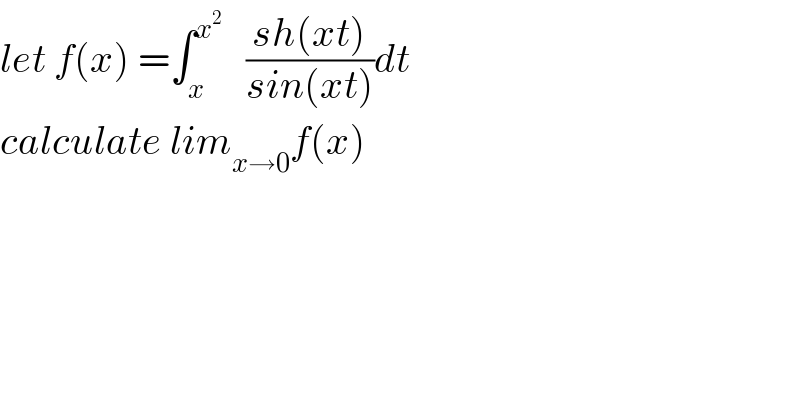
Question and Answers Forum
Previous in Relation and Functions Next in Relation and Functions
Question Number 74015 by mathmax by abdo last updated on 17/Nov/19

Commented by mathmax by abdo last updated on 18/Nov/19
![f(x)=∫_x ^x^2 ((sh(xt))/(sin(xt)))dt =_(xt =u) (1/x) ∫_x^2 ^x^3 ((sh(u))/(sin(u)))du ∃c ∈]x^2 ,x^3 [ / ∫_x^2 ^x^3 ((sh(u))/(sin(u)))du =sh(c) ∫_x^2 ^x^3 (du/(sinu)) ∫_x^2 ^x^3 (du/(sinu)) =_(tan((u/2))=t) ∫_(tan((x^2 /2))) ^(tan((x^3 /2))) (1/((2t)/(1+t^2 )))×((2dt)/(1+t^2 )) =[ln∣t∣]_(tan((x^2 /2))) ^(tan(((x3)/2))) =ln∣((tan((x^3 /2)))/(tan((x^2 /2))))∣∼ln∣x∣ (x→0) c=λx^2 +(1−λ)x^3 with 0<λ<1 ⇒f(x)∼((sh(c))/x)ln∣x∣ ∼sh(λx^2 +(1−λ)x^3 )ln∣x∣ ∼ (λx^2 +(1−λ)x^3 )ln∣x∣ =x^2 ln∣x∣(λ +(1−λ)x)→0 (x→0) ⇒lim_(x→0) f(x)=0](Q74086.png)
| ||
Question and Answers Forum | ||
Previous in Relation and Functions Next in Relation and Functions | ||
Question Number 74015 by mathmax by abdo last updated on 17/Nov/19 | ||
 | ||
Commented by mathmax by abdo last updated on 18/Nov/19 | ||
![f(x)=∫_x ^x^2 ((sh(xt))/(sin(xt)))dt =_(xt =u) (1/x) ∫_x^2 ^x^3 ((sh(u))/(sin(u)))du ∃c ∈]x^2 ,x^3 [ / ∫_x^2 ^x^3 ((sh(u))/(sin(u)))du =sh(c) ∫_x^2 ^x^3 (du/(sinu)) ∫_x^2 ^x^3 (du/(sinu)) =_(tan((u/2))=t) ∫_(tan((x^2 /2))) ^(tan((x^3 /2))) (1/((2t)/(1+t^2 )))×((2dt)/(1+t^2 )) =[ln∣t∣]_(tan((x^2 /2))) ^(tan(((x3)/2))) =ln∣((tan((x^3 /2)))/(tan((x^2 /2))))∣∼ln∣x∣ (x→0) c=λx^2 +(1−λ)x^3 with 0<λ<1 ⇒f(x)∼((sh(c))/x)ln∣x∣ ∼sh(λx^2 +(1−λ)x^3 )ln∣x∣ ∼ (λx^2 +(1−λ)x^3 )ln∣x∣ =x^2 ln∣x∣(λ +(1−λ)x)→0 (x→0) ⇒lim_(x→0) f(x)=0](Q74086.png) | ||